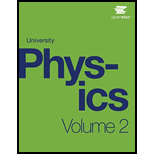
Concept explainers
 Chek sour Understanding A closely und coil has a radius of 4.0 cm. 50 turns, and a total ieslstancc of 40 . At what rae must a magnetic field peipendicular lathe face of the coil change En euler to prodice Joule hearing in the cull a a tale of 2.0 mW
Chek sour Understanding A closely und coil has a radius of 4.0 cm. 50 turns, and a total ieslstancc of 40 . At what rae must a magnetic field peipendicular lathe face of the coil change En euler to prodice Joule hearing in the cull a a tale of 2.0 mW
To Calculate:
The rate at which magnetic field perpendicular to the face of the coil carrying current changes in order to produce the given Joule heating in the coil.
Answer to Problem 13.1CYU
The rate change of the magnetic field is
Explanation of Solution
Given:
Radius of the coil,
Number of turns,
Total resistance,
Joule heating in the coil that is power,
Formula used:
Power loss in a circuit carrying current is,
Here
Emf produced in a coil is equal to negative of rate change of flux,
Here
Where, n is the number of turns,
From equation(1) current in the coil is given as,
Substituting the value of
And also power
From equation (2) and equation (3), the emf produced in the coil is
So, the rate at which magnetic field is changing is
Substituting the value of
Conclusion:
Thus, the rate at which the magnetic field perpendicular to the face of the coil carrying current should change is
Want to see more full solutions like this?
Chapter 13 Solutions
University Physics Volume 2
Additional Science Textbook Solutions
Human Biology: Concepts and Current Issues (8th Edition)
Cosmic Perspective Fundamentals
Anatomy & Physiology (6th Edition)
Living By Chemistry: First Edition Textbook
Genetic Analysis: An Integrated Approach (3rd Edition)
Applications and Investigations in Earth Science (9th Edition)
- 20. Two small conducting spheres are placed on top of insulating pads. The 3.7 × 10-10 C sphere is fixed whie the 3.0 × 107 C sphere, initially at rest, is free to move. The mass of each sphere is 0.09 kg. If the spheres are initially 0.10 m apart, how fast will the sphere be moving when they are 1.5 m apart?arrow_forwardpls help on allarrow_forwardpls help on thesearrow_forward
- pls help on all asked questions kindlyarrow_forwardpls help on all asked questions kindlyarrow_forward19. Mount Everest, Earth's highest mountain above sea level, has a peak of 8849 m above sea level. Assume that sea level defines the height of Earth's surface. (re = 6.38 × 106 m, ME = 5.98 × 1024 kg, G = 6.67 × 10 -11 Nm²/kg²) a. Calculate the strength of Earth's gravitational field at a point at the peak of Mount Everest. b. What is the ratio of the strength of Earth's gravitational field at a point 644416m below the surface of the Earth to a point at the top of Mount Everest? C. A tourist watching the sunrise on top of Mount Everest observes a satellite orbiting Earth at an altitude 3580 km above his position. Determine the speed of the satellite.arrow_forward
- pls help on allarrow_forwardpls help on allarrow_forward6. As the distance between two charges decreases, the magnitude of the electric potential energy of the two-charge system: a) Always increases b) Always decreases c) Increases if the charges have the same sign, decreases if they have the opposite signs d) Increases if the charges have the opposite sign, decreases if they have the same sign 7. To analyze the motion of an elastic collision between two charged particles we use conservation of & a) Energy, Velocity b) Momentum, Force c) Mass, Momentum d) Energy, Momentum e) Kinetic Energy, Potential Energyarrow_forward

 Physics for Scientists and Engineers: Foundations...PhysicsISBN:9781133939146Author:Katz, Debora M.Publisher:Cengage Learning
Physics for Scientists and Engineers: Foundations...PhysicsISBN:9781133939146Author:Katz, Debora M.Publisher:Cengage Learning Glencoe Physics: Principles and Problems, Student...PhysicsISBN:9780078807213Author:Paul W. ZitzewitzPublisher:Glencoe/McGraw-Hill
Glencoe Physics: Principles and Problems, Student...PhysicsISBN:9780078807213Author:Paul W. ZitzewitzPublisher:Glencoe/McGraw-Hill
 Physics for Scientists and Engineers, Technology ...PhysicsISBN:9781305116399Author:Raymond A. Serway, John W. JewettPublisher:Cengage Learning
Physics for Scientists and Engineers, Technology ...PhysicsISBN:9781305116399Author:Raymond A. Serway, John W. JewettPublisher:Cengage Learning College PhysicsPhysicsISBN:9781938168000Author:Paul Peter Urone, Roger HinrichsPublisher:OpenStax College
College PhysicsPhysicsISBN:9781938168000Author:Paul Peter Urone, Roger HinrichsPublisher:OpenStax College





